4 Pack Solar Ultrasonic Nocturnal Animal Repeller with Red and Blue Predator Lights
$35.99 Original price was: $35.99.$32.99Current price is: $32.99.
Keep night visitors off your beds and away from your birds with this 4 Pack Solar Ultrasonic Animal Repeller. Each unit pairs motion-sensing ultrasonics with flashing red and blue predator eyes, a humane combination that startles deer, foxes, raccoons, and coyotes during the hours they are most active around people. Use it as a smart perimeter layer around coop corners, garden entries, and fence lines, and rotate placement to keep animals from getting used to it. Extensions note that motion-activated lights and similar frightening devices can help when combined with good yard hygiene and basic barriers.
Description
When nighttime visitors turn your yard into a buffet, this 4 Pack Solar Ultrasonic Nocturnal Animal Repeller with Red and Blue Predator Lights steps in to protect what you care about. The mix of motion-sensing ultrasonics and flashing “eyes” is designed to unsettle deer, foxes, coyotes, raccoons, and stray cats around gardens and chicken coops, right when many of them are most active after dark. Independent wildlife guidance notes that coyotes often shift to nighttime activity in towns to avoid people, which is exactly when light and sound scare tactics can help you tip the odds back in your favor.
Key Customer Benefits
- Timed for when wildlife actually shows up: Most backyard raids happen after dark. Urban coyotes and other mid-sized predators shift activity into evening and night to avoid people, so a night-active solar ultrasonic animal repeller with red and blue predator lights is working at the right hours around your coop and garden.
- Humane, non-chemical protection that layers with what works: Use these as a friendly first line while you keep yards tidy and secure easy food. Wildlife agencies and extensions list motion-triggered lights, sprinklers, and other startle tools as acceptable deer and predator deterrents, especially when combined with sanitation and exclusion.
- Light plus sound for more “surprise value”: Steady porch lights become background. Field reviews of frightening devices and tests of movement-activated guards show that combining visual flashes with noise can reduce visits and feeding in treated areas, particularly in the short term before animals adapt. That is exactly the combo these units deliver.
- Honest science on ultrasonics, used the right way: Universities and reviews find ultrasonic repellers alone are inconsistent and animals can habituate, which is why professionals rotate devices, change angles, and pair them with other cues. Treat the ultrasound as one layer, not the whole plan.
- Set-and-forget solar convenience that cuts chores: No cords to run to the back fence and no nightly switch-on. Solar charging and motion activation mean you spend your time tending plants and birds, not gear. Pair two units on approach lanes and two on corners, then rotate positions every couple of weeks to keep the startle fresh, as frightening-device guidance suggests.
- Stronger coop safety when you pair with real exclusion: Use the repellers to push prowlers back while your coop does the heavy lifting. Extension programs recommend half-inch hardware cloth, buried skirts or aprons to stop digging, and tight latches for raccoons and foxes. That combo is what keeps flocks calm at night.
Product Description
What this Animal Repeller is
This set is a solar ultrasonic animal repeller with red and blue predator lights designed for nighttime protection around gardens, yards, and chicken coops. Each unit typically includes a small solar panel, a rechargeable battery, a passive infrared motion sensor, an ultrasonic speaker, and flashing LEDs that look like eyes when they fire. This repeller sits quietly by day and, after dusk, it watches for movement and startles approaching animals with light plus sound. Wildlife control manuals classify these as frightening devices. They can help when used early, positioned well, and paired with good yard hygiene and basic barriers.
How it works
When a deer, fox, raccoon, or coyote approaches, the PIR sensor trips and the unit does two things at once. It emits a burst of ultrasonic sound and flashes the red and blue LEDs. Research on non-lethal predator deterrents shows that unexpected stimuli, especially at night, can reduce approaches to livestock and gardens, particularly in the short term before animals get used to them. Field experiments with flashing lights have reported fewer night attacks on livestock in some settings, although results vary by predator and site. Extension and wildlife reviews also note that devices which combine cues such as light plus sound have better short-term effect than a single cue alone.
Urban and suburban coyotes, along with raccoons and foxes, often shift activity into the night to avoid people. That simple timing detail is why a night-active, motion-triggered deterrent can pull its weight around a coop or vegetable bed. Agencies and research groups that study urban coyotes describe this nocturnal shift as a common response to human presence. If your trail cam shows most visits after dark, gear that wakes up at sunset is working during the right hours.
What makes this different
A steady porch light becomes background. These units try to surprise, which matters for deer and mid-sized predators. State and university guidance on deer damage control consistently list motion-activated lights, sprinklers, and noisemakers as humane options that can reduce browsing for a time, especially when you use several devices and move them. You are getting that same startle principle here, with the convenience of solar power and automatic night mode so you are not chasing cables to the back fence.
Ultrasonic repellers on their own have mixed evidence. Reviews and lab tests have found low or inconsistent repellency across species, and wildlife professionals warn that mammals and birds can habituate to repeating stimuli. That does not make these useless. It means you should use them like a pro: position at the approach paths, angle at animal chest height, rotate locations every couple of weeks, and remove attractants such as spilled feed, unsecured trash, fallen fruit, or easy entry points to the coop. Pair them with real exclusion like half-inch hardware cloth and tight latches, which extensions recommend as the backbone of predator protection.
Product Specifications
| Spec | Details |
|---|---|
| Power and charging | Built-in solar panel charges an internal battery by day. Many units also accept 5-volt USB input for top-ups in cloudy weather. Example manual lists a 5-volt, 120 milliamp solar panel and 5-volt 1-amp USB input. |
| Battery type | Common configurations include a single 3.7-volt 18650 lithium cell rated around 2200 milliamp hours, or a pack of rechargeable AA cells in some models. Check your unit’s label before replacement. |
| Sensors | Passive infrared motion sensor, typically about 110 degrees field of view with trigger distance roughly 8 to 10 meters, which is about 26 to 33 feet, depending on animal size and ambient temperature. |
| Ultrasonic output | Most manuals list adjustable or dual modes within roughly 15 to 60 kilohertz. This aligns with specs such as 15 to 50 kilohertz and 20 to 60 kilohertz in current manuals. |
| LED predator eyes | Night-only flashing, usually red or red plus blue. Some wall-mount versions specify about four flashes per second to simulate a threat signal. |
| Stated coverage | Vendor claims vary. One 4-pack listing quotes about 2,425 square feet per set. In practice, the effective activation zone is set by the PIR sensor and is closer to a 26 to 33 foot arc in front of each unit. |
| Weather resistance | Listings span from splash resistant to more sealed builds. Expect ratings around IP44 on many repellers, with some upgraded housings advertised as IP55 to IP66. Place where the panel can dry quickly and avoid submersion. |
| Housing material | ABS plastic body and stake or wall plate. |
| Mounting options | Ground spike for garden beds, or screw slots for fence and wall mounting. Manuals advise setting the lens toward likely approach paths and keeping the solar panel in full sun. |
| Operating schedule | Light sensor enables night operation automatically. Many ultrasonic models also work by day, but red or blue eyes are designed to trigger after dusk. |
| Best-practice placement height | Mount at the eye level of the animal you want to deter. Several predator-light listings recommend roughly 1 to 8 feet off the ground; rotate position every couple of weeks to reduce habituation. |
| Safety with pets and people | Ultrasonic tones are generally above human hearing, but dogs and cats can detect much higher frequencies. Monitor pet behavior and move or disable units if pets seem stressed. Avoid use near rodent pets like hamsters or gerbils. |
| Certifications to look for | Many branded ultrasonic repellents publish FCC, CE and RoHS compliance. Check your packaging or manual and keep the paperwork for warranty claims. |
| What to verify on arrival | Battery type and capacity, stated IP rating, included hardware, and whether USB cable or wall adapter is provided. Several manuals note that a 5-volt 1-amp adapter is not included. |
How to Use and Install
Step 1. Walk your yard at dusk and map the approach lanes
Look for the paths deer and mid-size predators already use. Common routes are along fence lines, hedges, dry creek beds, and the back of a chicken run. State and university guidance on deer control recommends startle devices like motion-activated lights and sprinklers on the exact approaches animals use, not randomly in the yard. That is the idea here too.
Step 2. Unbox and give each unit a full solar top-up
Set the repellers in direct sun for a full charging day before first use. Small solar panels harvest more energy when they are angled toward the sun and kept clean. Reputable solar guides note that facing panels toward the equator and tilting roughly to local latitude improves year-round capture. In practice, keep the little panel pointed to open sky, avoid shade from eaves or shrubs, and wipe dust off with a soft cloth.
Step 3. Mount at animal eye level and face outward from what you are protecting
For chicken coops, place units at the corners of the run so a fox or raccoon sees the eyes and triggers the sensor before it reaches the fence. Predator-light manufacturers advise mounting at the eye level of the target animal and pointing away from the asset so the intruder sees the flash as it approaches. For deer, a cluster of four lights around four feet high facing north, south, east, and west on a single post is a proven visual pattern. Ultrasonic models can follow the same geometry.
Do the fundamentals first. Lock birds in every night, use half-inch hardware cloth or welded mesh, and secure latches. University and extension resources call that the first line of defense and recommend burying or skirting wire to stop digging. Your solar ultrasonic animal repeller is the outside alarm that reduces casual night visits.
Step 4. Aim the sensor across the path, not straight down the fence
Passive infrared sensors detect side-to-side movement best. Security sensor manuals and install sheets say to avoid aiming directly at hot surfaces or vents and to mount where targets will cross the detection beams. Place the lens so it views the approach lane, then test by walking the path yourself after dark.
Step 5. Space and overlap
Think in overlapping cones. A typical PIR arc is roughly 26 to 33 feet at night depending on temperature and target size. Put units so one cone hands off to the next around corners and along trails. If deer browse a long bed, set one unit mid-span and two more at each end so movement from either direction trips an alert. Rotate angles or shift posts by a few yards every couple of weeks so animals do not get used to a fixed pattern. Extensions highlight that frightening devices lose power if never moved.
Step 6. Blend light with other startle tools where pressure is high
In gardens with heavy deer pressure, agencies and universities advise mixing motion-activated lights with sprinklers or sound for more surprise value. If you add a motion sprinkler on the same approach, keep its sensor slightly offset so the light fires first and the water blast follows a second later. That sequence often turns a cautious grazer into a retreat.
Step 7. Coop integration that backyard keepers swear by
After your repellers are up, harden the coop so a determined raccoon still fails. Use half-inch hardware cloth on windows and vents, fix a dig-proof skirt or bury the mesh outward about a foot, and use human-only latches. Extensions document raccoon behavior and recommend heavy-gauge mesh and top coverage of runs, since raccoons climb. This combination, secure housing inside plus startling lights and sound outside, is what keeps flocks calm at night.
Step 8. Night testing and fine-tuning
Switch the units to night mode and walk the approach line at different distances. You want instant flashes and tone from every likely angle. If a unit is slow to react, raise it a few inches or pivot it across the path. If a shrub or fence post blocks the lens, nudge the post location. Quick ten-minute checks after dark pay off for the whole season. Guidance on sensor placement confirms that small changes in height and tilt change real-world range.
Step 9. Maintenance schedule that prevents silent failures
Every two to four weeks: wipe the solar lens, check for spider webs over the PIR window, and confirm the flash at dusk. Solar references remind owners that dust and shade drop output. After storms, recheck angles and trim any new shade. If your model supports USB charging, give it a top-up after long cloudy runs.
Step 10. Safety with pets and neighbors
Dogs and cats can hear far higher frequencies than people. Watch your own animals for signs of stress, especially in small yards. If a dog fixates on a unit, pivot it outward or raise the height so the cone crosses the perimeter rather than your patio. For close neighbors, angle units away from bedroom windows and use the lower flash setting if available. Guidance on motion-sensor placement also recommends avoiding lines of sight into windows.
Common Issues
- Deer are back after two weeks. Move the posts a few yards, change heights by half a foot, and combine with a motion sprinkler on the hottest trail. Agencies note that rotating frightening devices restores short-term effect.
- Trail cam shows a raccoon at the fence. Strengthen the run. Add half-inch hardware cloth to any soft spot and cover the roof of the run because raccoons climb. Lock feed away each night to remove attractants.
- Units did not flash last night. Clean the solar lens and give a daytime recharge. If your model allows USB, top up after a string of cloudy days.
Frequently Asked Questions
Do ultrasonic animal repellers really work on deer, coyotes, or raccoons?
Sometimes, but not as a stand-alone fix. University and extension reviews find ultrasonic devices have mixed or low effectiveness across species, and animals can get used to them when a strong reward such as food is available. This is why professionals treat ultrasonics as one layer, then combine them with flashing lights, motion sprinklers, and real exclusion like fencing and hardware cloth.
Will flashing predator lights help around a chicken coop at night?
They can reduce casual night visits when placed on the approach paths and rotated. Backyard chicken keepers report success when lights are part of a layered setup that includes secure latches and half-inch hardware cloth. Keep expectations realistic. Even extensions note that frightening devices work best short-term and need to be moved to avoid habituation.
What is the best placement height and angle for the sensors?
Mount roughly at the eye level of the animal you are trying to deter and aim across the path so the PIR sensor detects side-to-side movement. General motion-sensor guidance recommends clear lines of sight and corner placements to widen coverage. In practice for yards, that is about knee high for foxes and raccoons, chest high for deer, and pointed outward from the coop or bed you are protecting.
How far do these units reach?
Treat the effective zone like a cone about 8 to 10 meters in front of each unit, which is roughly 26 to 33 feet, depending on temperature and the size of the animal. Overlap the cones from your 4-pack so an animal coming from any direction triggers at least one device. Extension pages recommend using several frightening devices and moving them regularly for best results.
Will the lights or sound bother my chickens at night?
Chickens are diurnal and usually sleep through short, occasional flashes outside the coop walls. The greater risk to your flock is a predator finding a weak point. Extensions emphasize secure construction first. Use half-inch hardware cloth on vents and windows, strong latches, and a dig-proof skirt or buried wire. Then add lights and sound outside the perimeter to reduce approaches.
Are these devices safe around pets and neighbors?
Humans hear up to about 20 kilohertz, while dogs and cats can hear much higher. Some pets may notice ultrasonic bursts and find them annoying. Watch your own animals; if they seem stressed, pivot the unit outward, raise the height, or reduce sensitivity. Also aim units away from bedroom windows. General motion-sensor guidance recommends avoiding direct lines of sight into windows.
Do deer and coyotes really move more at night in towns?
Yes, many do. Research on urban coyotes shows they reduce daytime activity around people and become more nocturnal. That is why night-only light and sound startling can be well timed around coops and gardens.
Can I skip fencing if I install these?
No. Think of them as an alarm and a nudge, not a wall. Agencies and university guides list motion-activated lights, sprinklers, and noisemakers as humane deterrents. They work best alongside good sanitation and physical exclusion such as solid fencing or welded mesh on runs. For deer pressure, add height or electric strands; for coops, cover the run and lock up every night.
How often should I move the units?
Every couple of weeks, or sooner if your trail cam shows animals getting comfortable again. Extensions caution that deer and other wildlife can become accustomed to fixed frightening devices. Changing height, angle, and location restores the surprise factor.
What maintenance keeps solar units reliable?
Keep the small solar panel clean and in open sun. Dust and shade reduce charging. After long cloudy spells, top up with USB if your model supports it. Re-check after storms, trim new shade, and test activation at dusk.
Will this help with foxes specifically?
Foxes can be sensitive to novel lights and sounds, so the flashing eyes plus ultrasonic bursts can discourage quick passes. Still, the most reliable fox protection for poultry is physical exclusion such as strong fencing and roof netting, with electrified strands where allowed. Use the repellers to reduce scouting and approaches while the fence does the real work.
Conclusion
If your trail cam keeps catching deer noses in the lettuce or a fox circling the coop, this 4 Pack Solar Ultrasonic Nocturnal Animal Repeller with red and blue predator lights gives you a fast, non-chemical way to push nighttime visitors back. It works during the hours when many suburban predators are most active, since studies show urban coyotes and similar wildlife reduce daytime movement around people and shift activity into the night. That timing is exactly where light and sound startle tools help you regain control.
Ultrasonic outputs alone are not a silver bullet. Extension reviews and independent tests find mixed or low effectiveness if you rely on sound only, and animals can learn to ignore a fixed pattern. The real win is combining cues and rotating placement. Use the flashing eyes plus ultrasonic bursts as a perimeter alarm, then reinforce your setup with clean yard habits, secure storage of feed, and physical exclusion where it matters most.
Related products
-
Bird-X Yard Gard Ultrasonic Animal Repeller with Motion Sensor – 4,000 sq ft Coverage
$42.52 Buy Now -
FAYINWBO Solar Ultrasonic Animal Repeller with Siren and Flashing LEDs for Yards and Gardens
$49.99 Buy Now -
Cleanrth TSBR620 Sonic and Ultrasonic Bird Repeller with Triple Scan Technology
$74.99 Buy Now -
2-Pack Solar Ultrasonic Animal Repeller with Motion Sensor and Strobe Light for Yard and Garden
$52.99 Buy Now
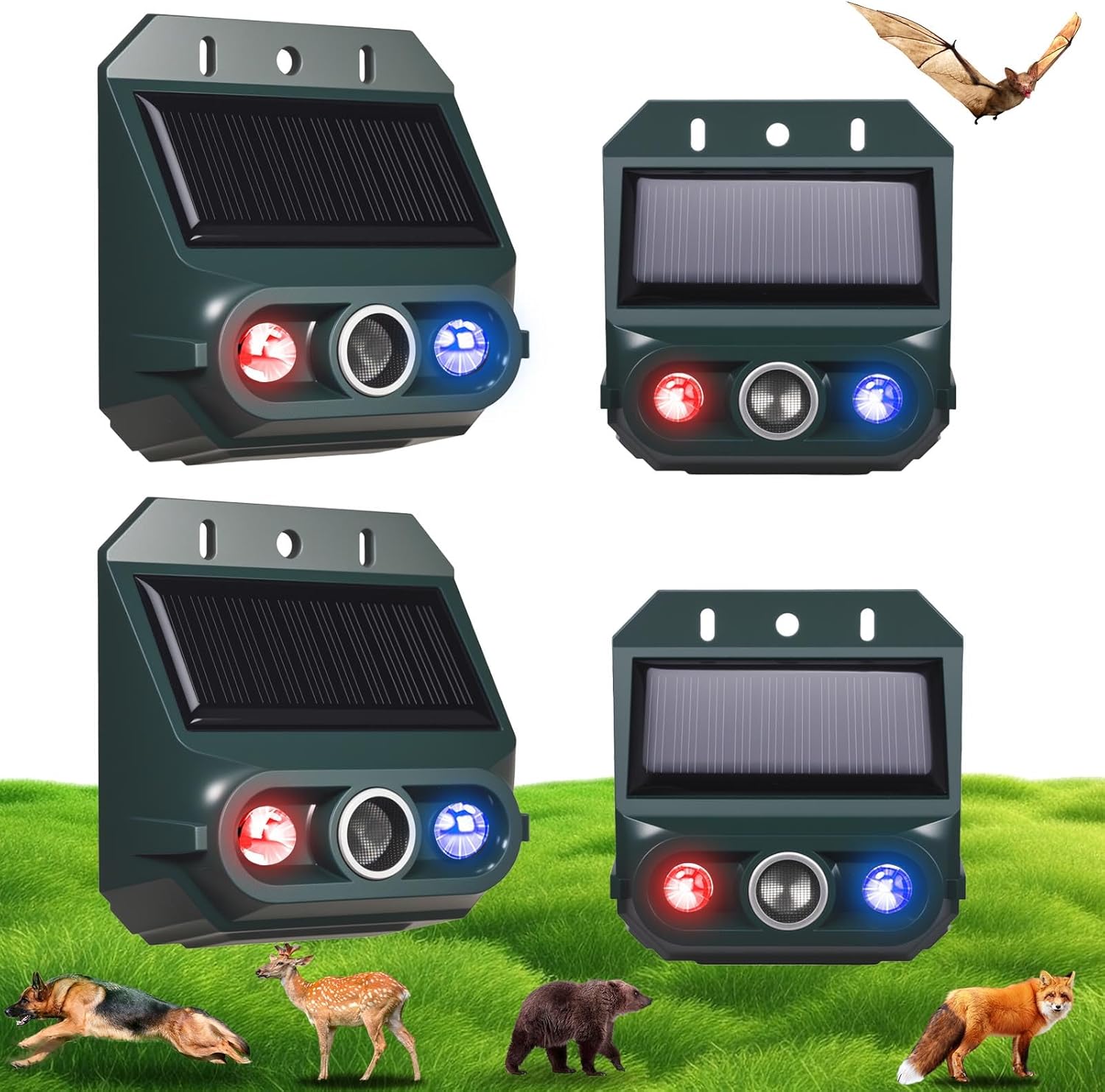
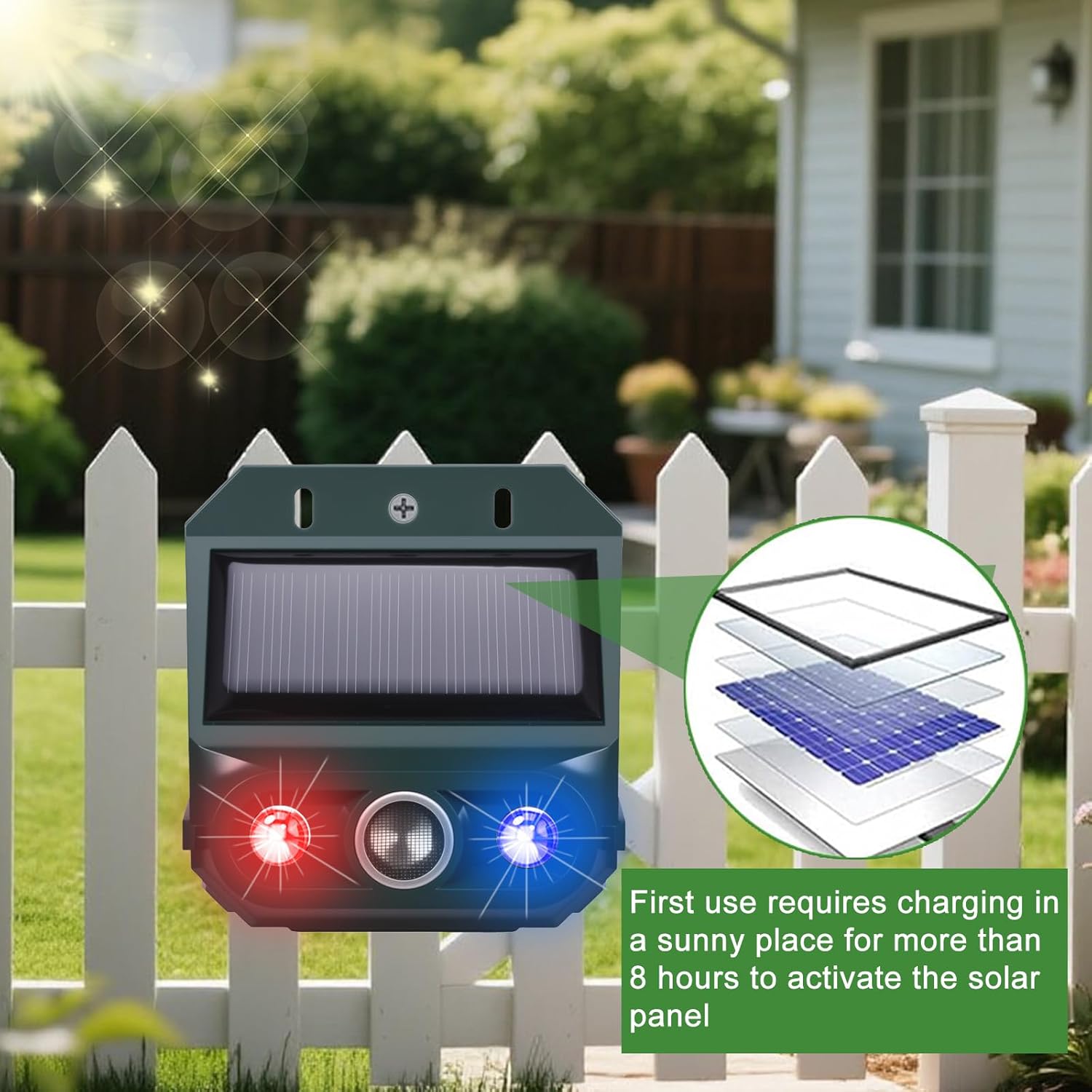
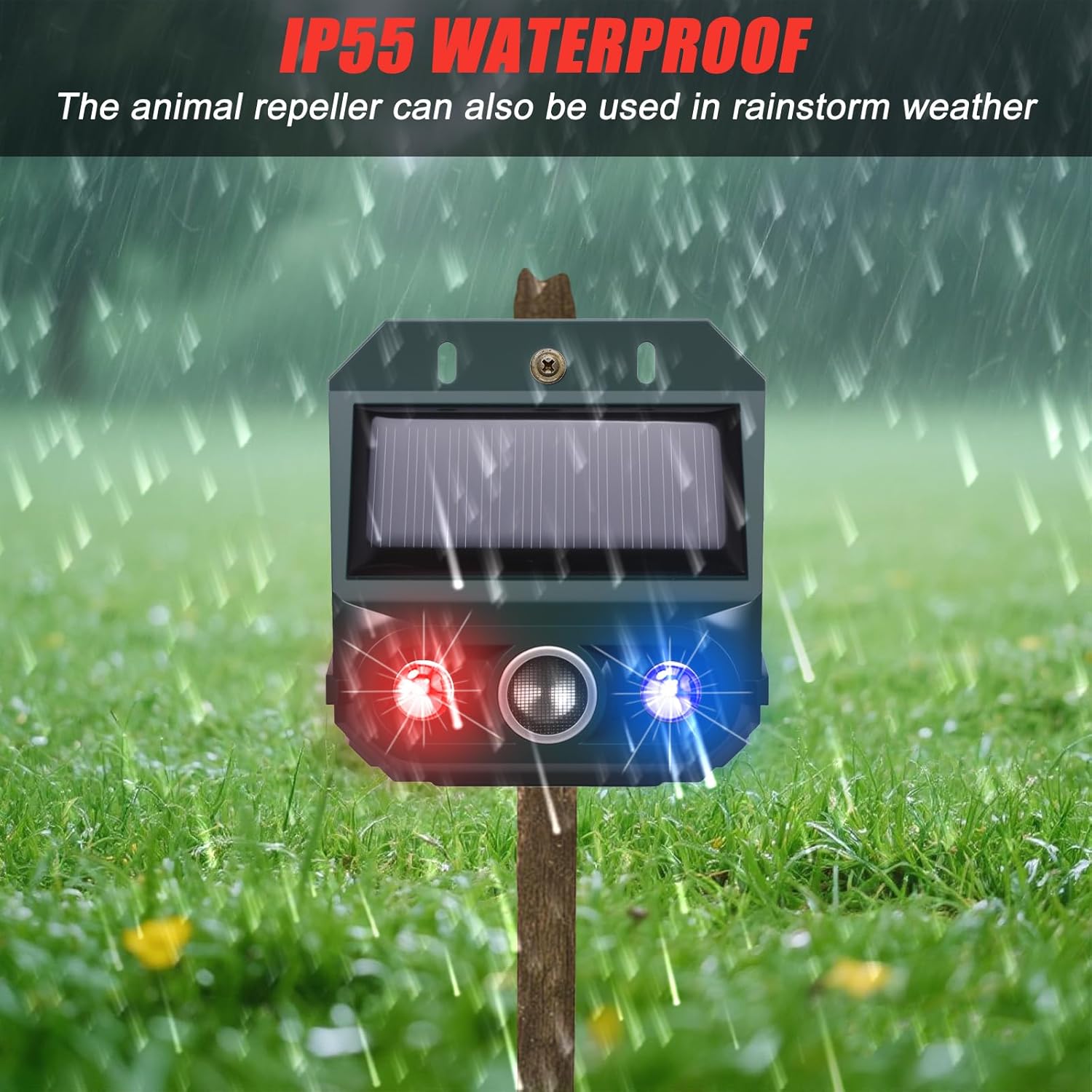
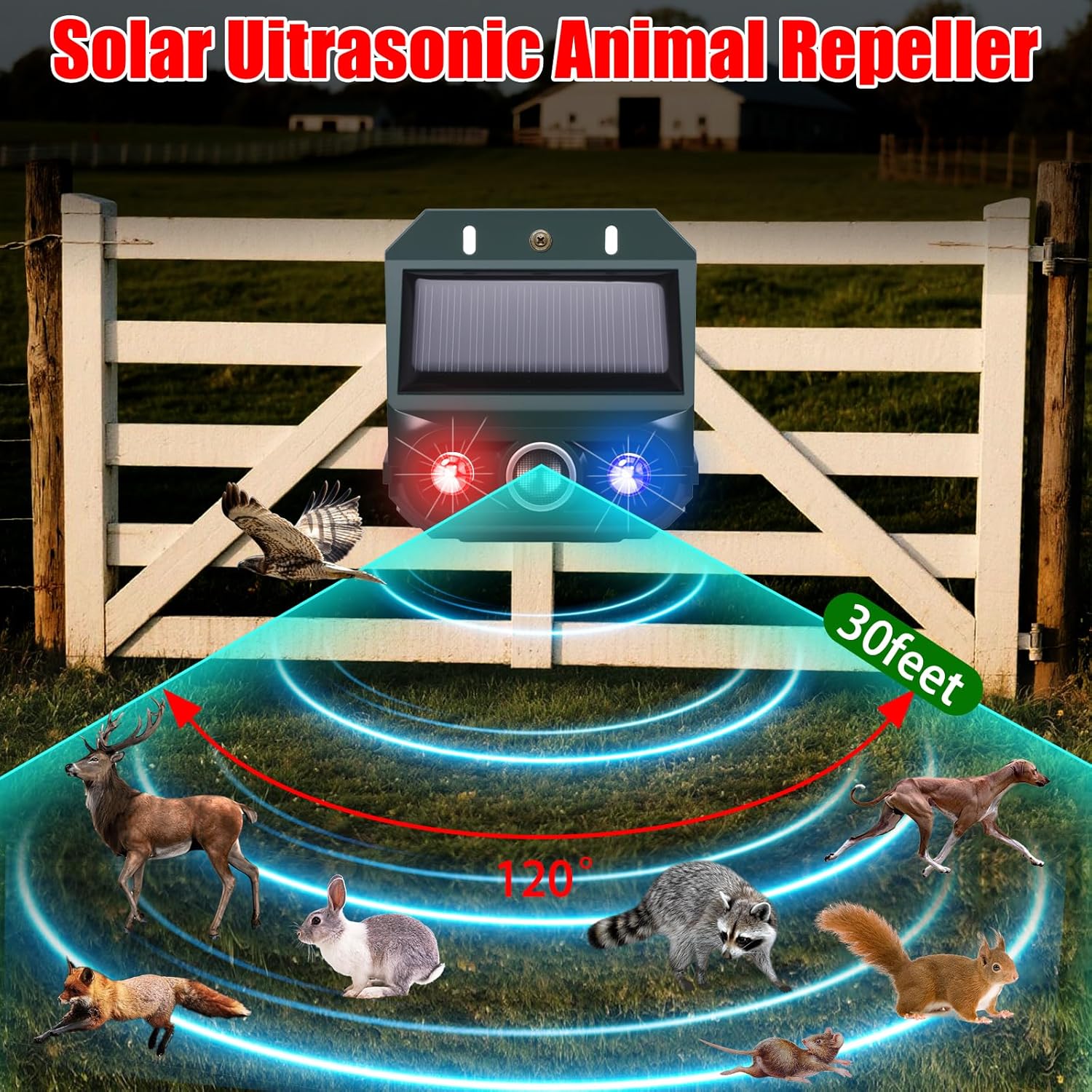
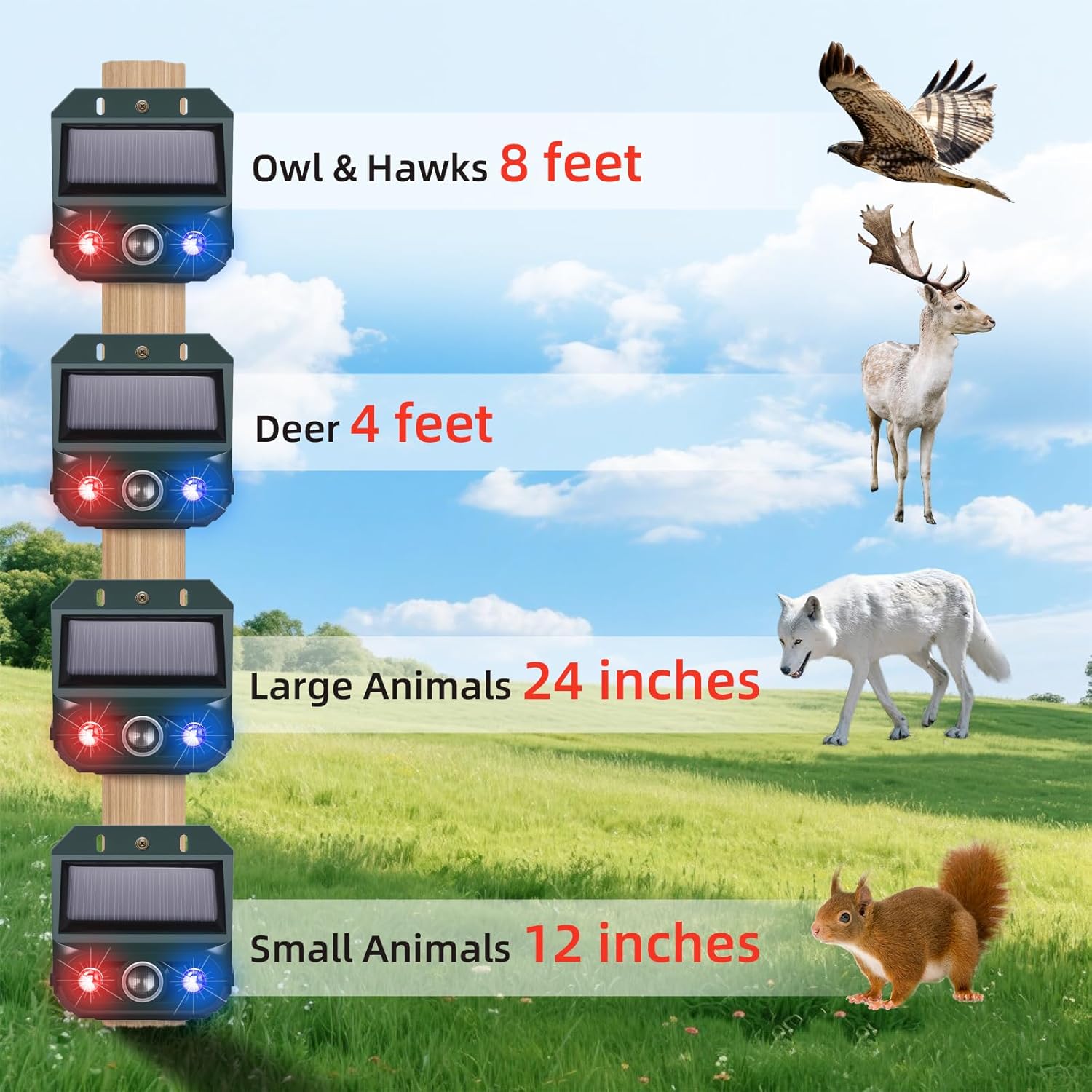
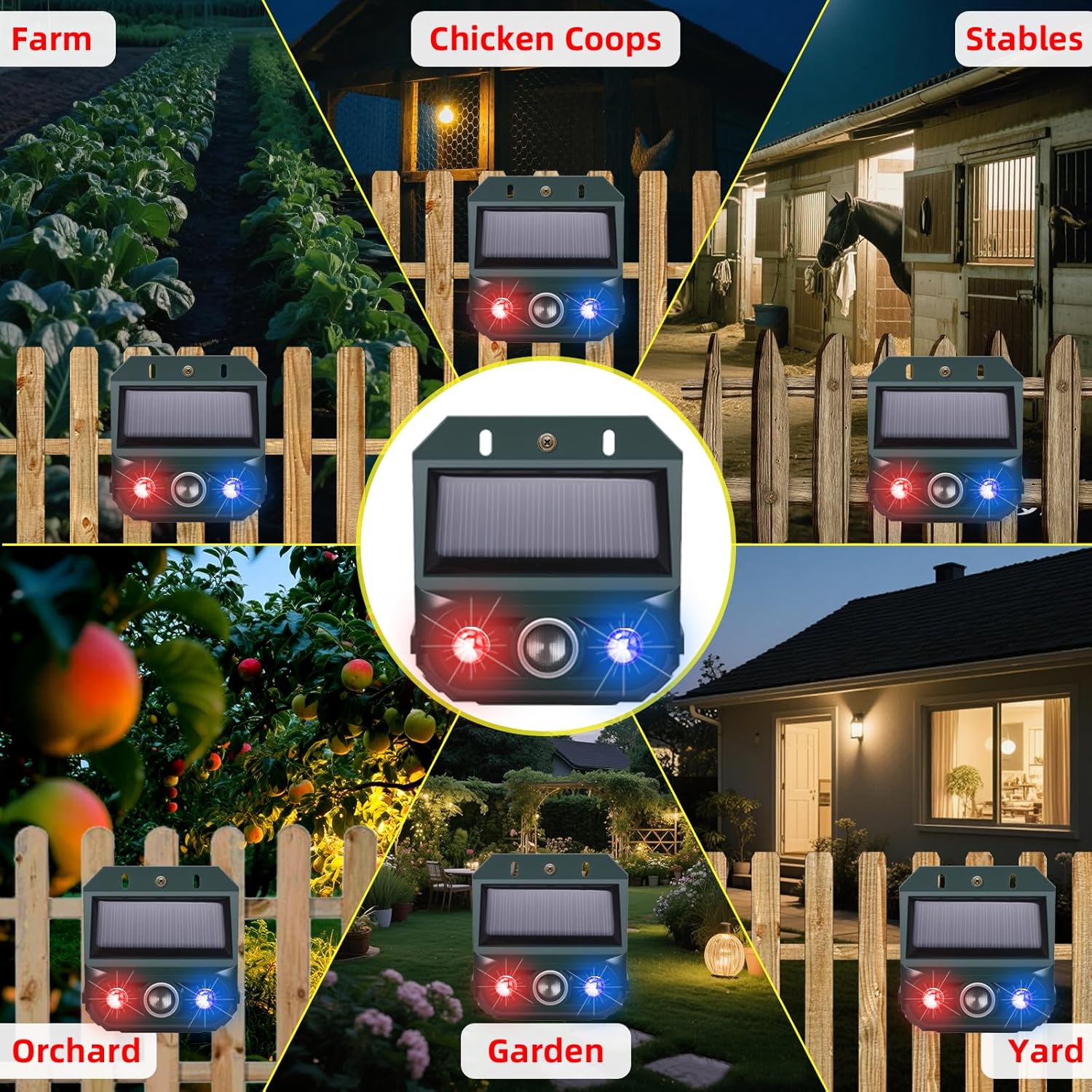
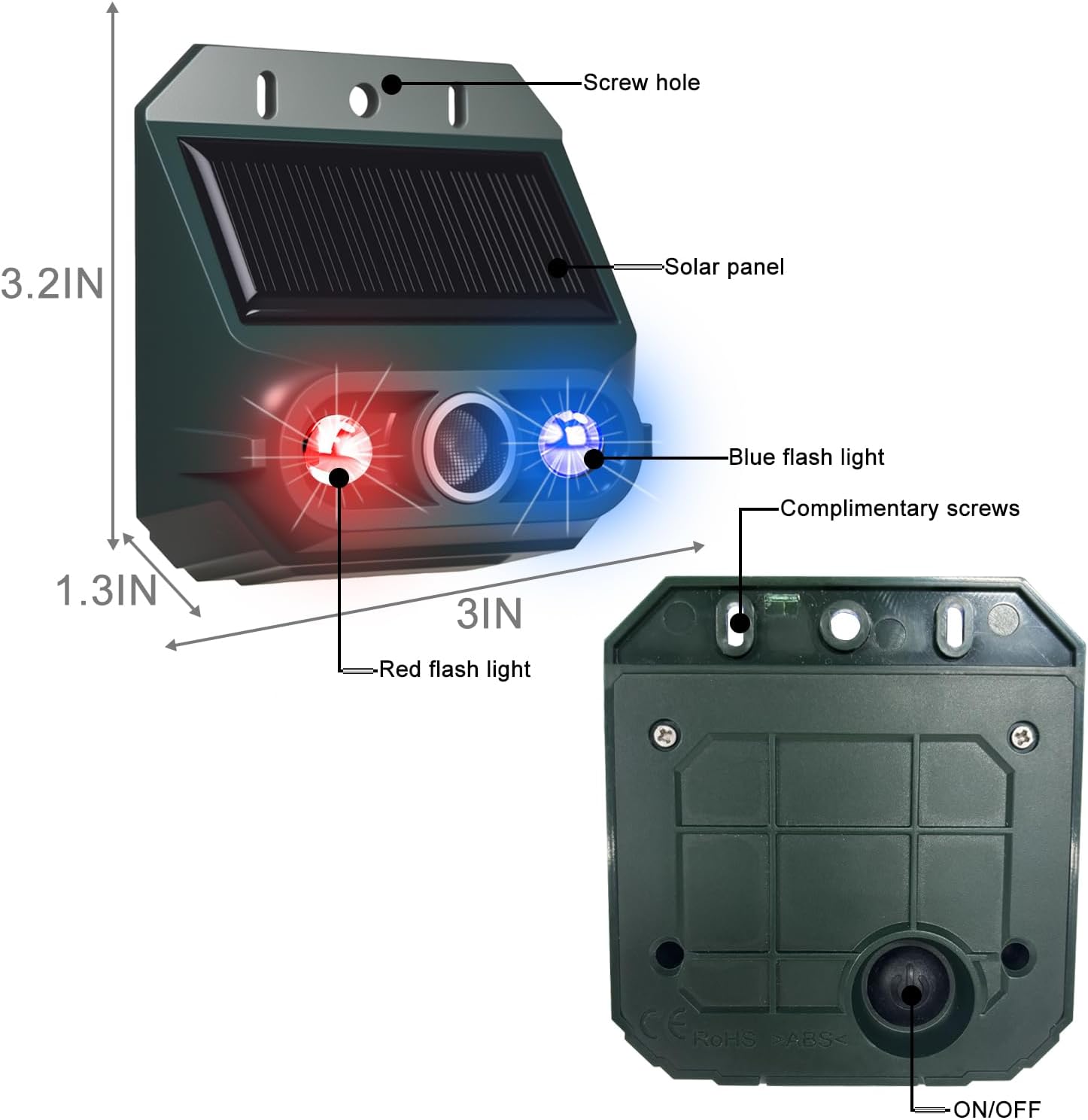
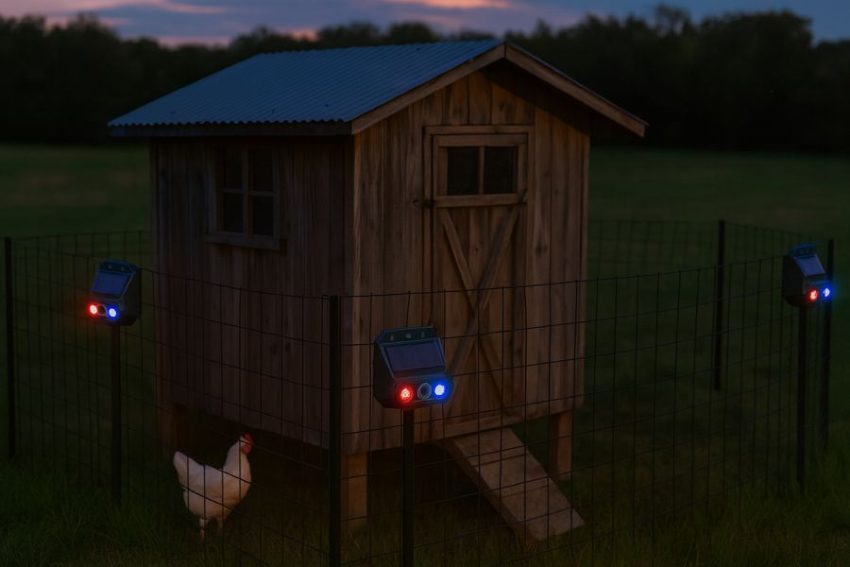
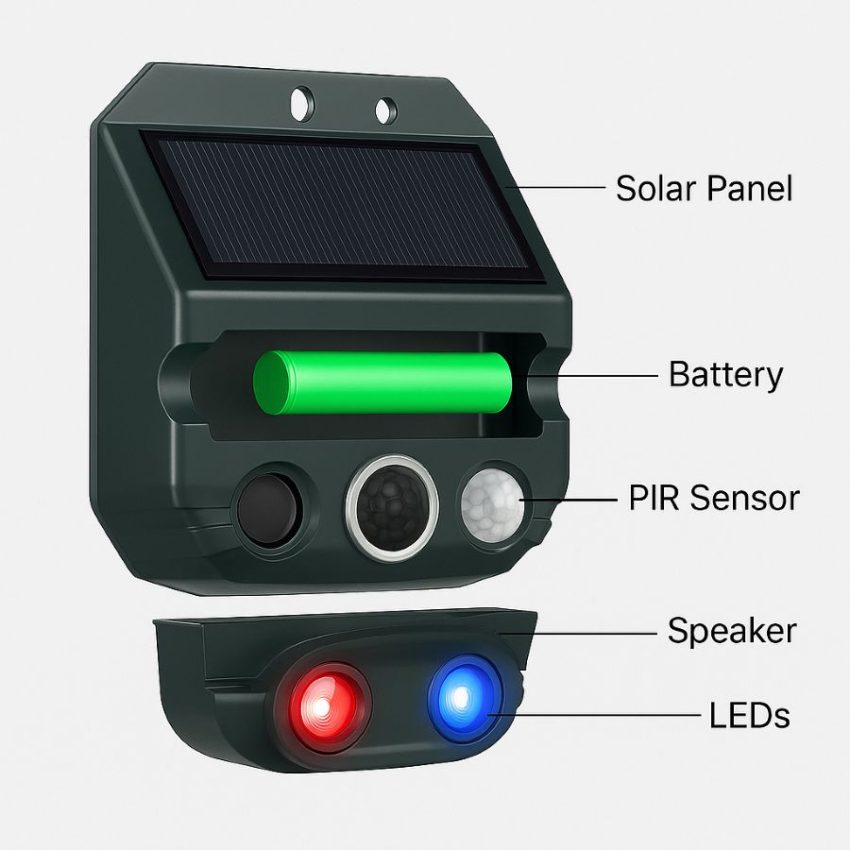
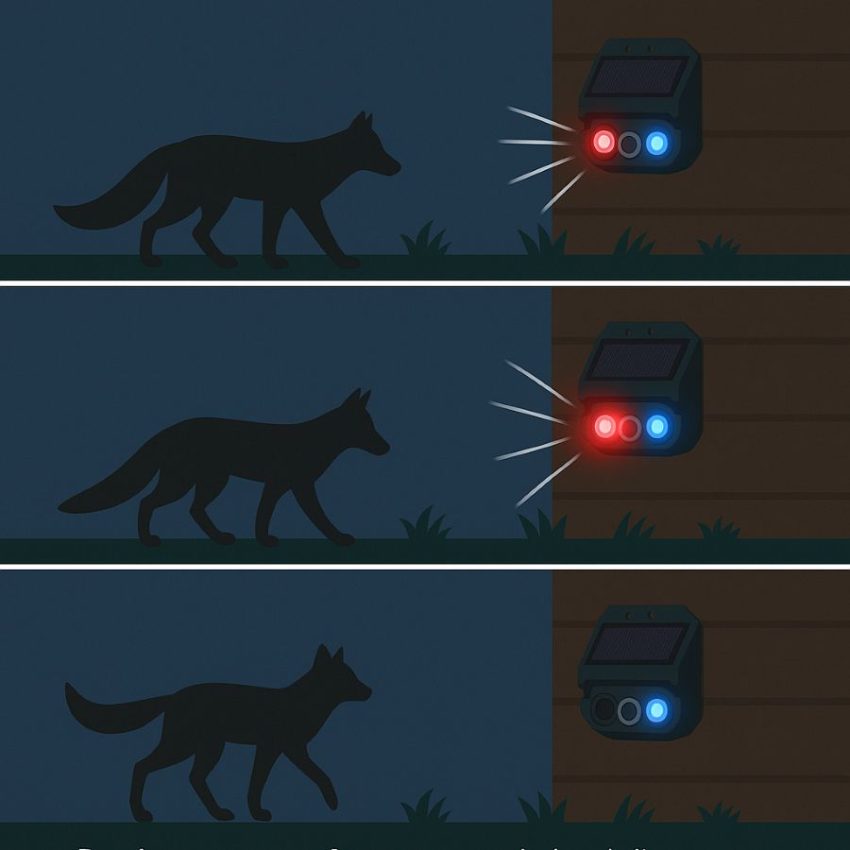
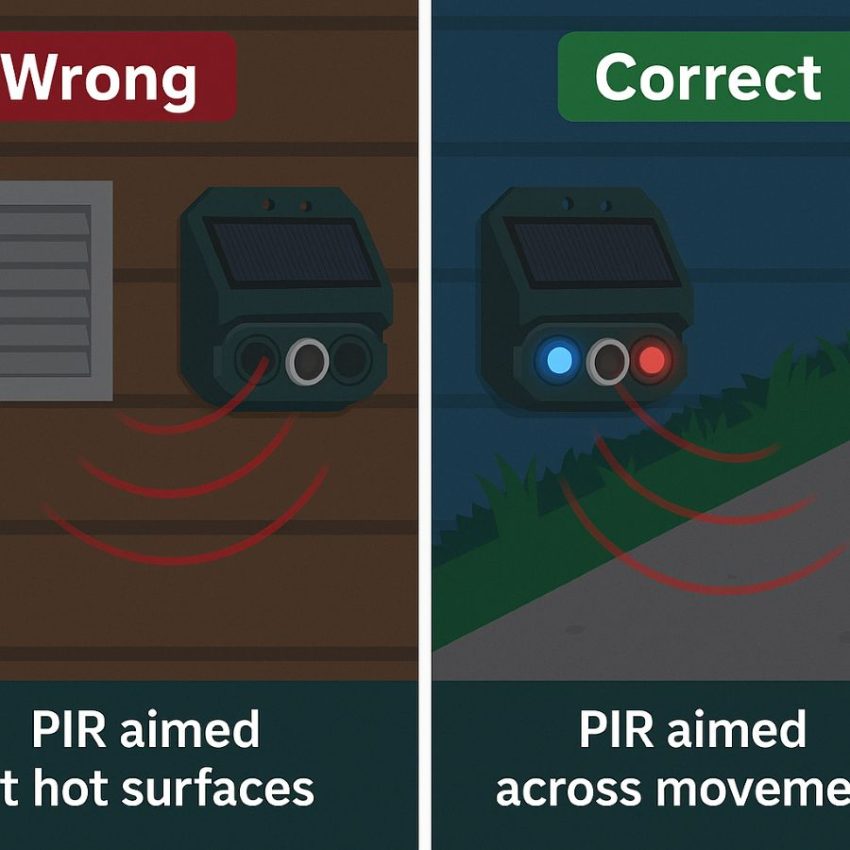
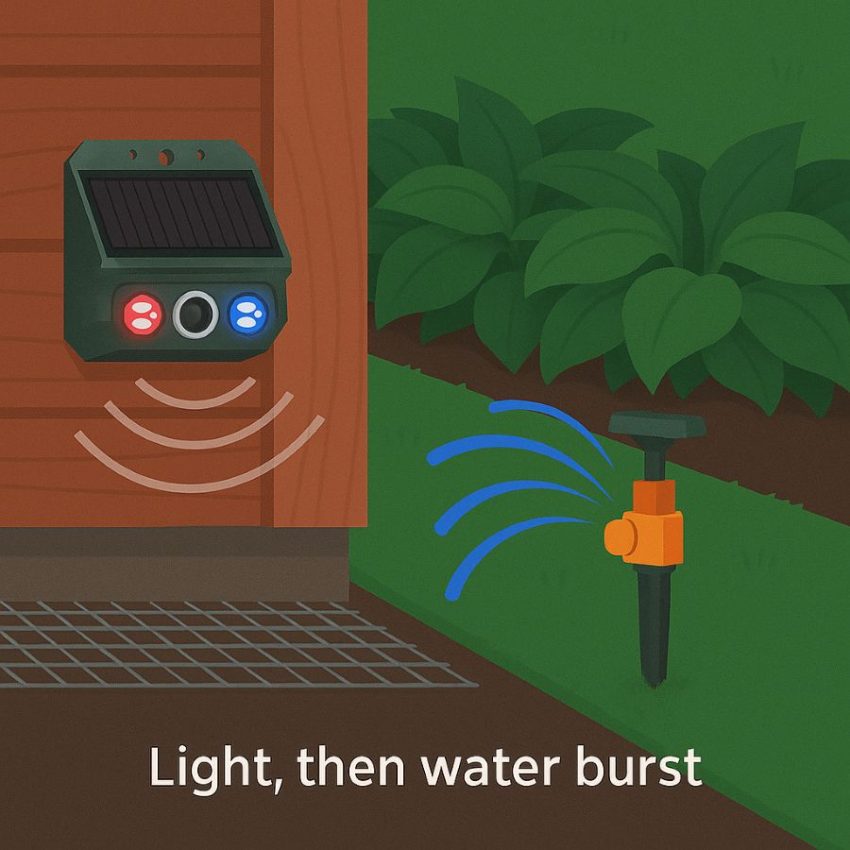
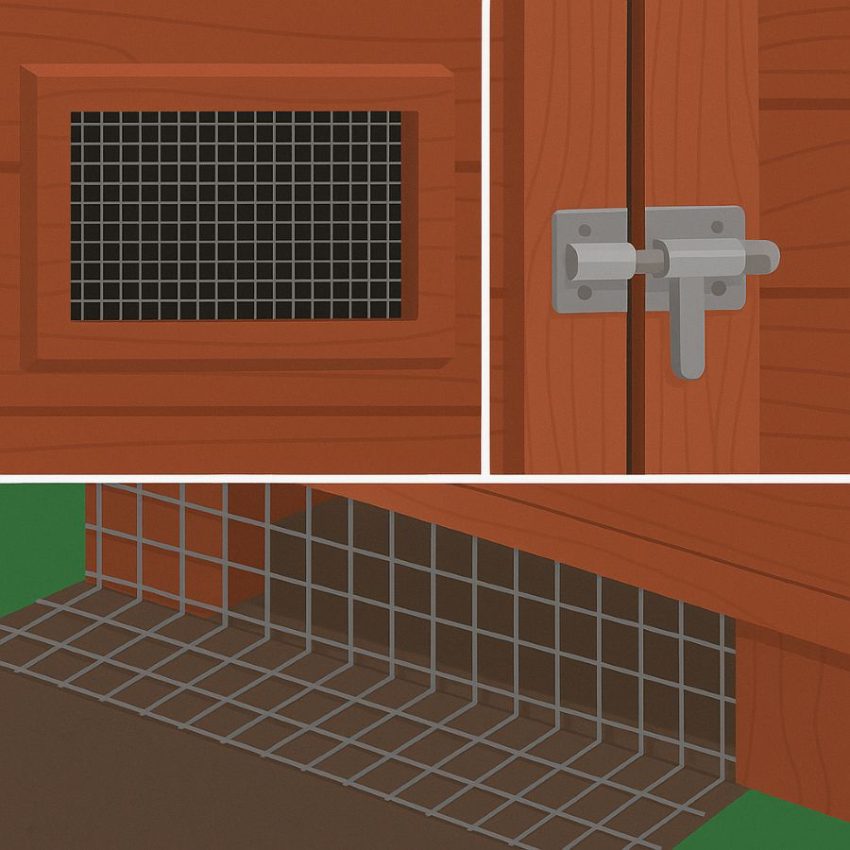
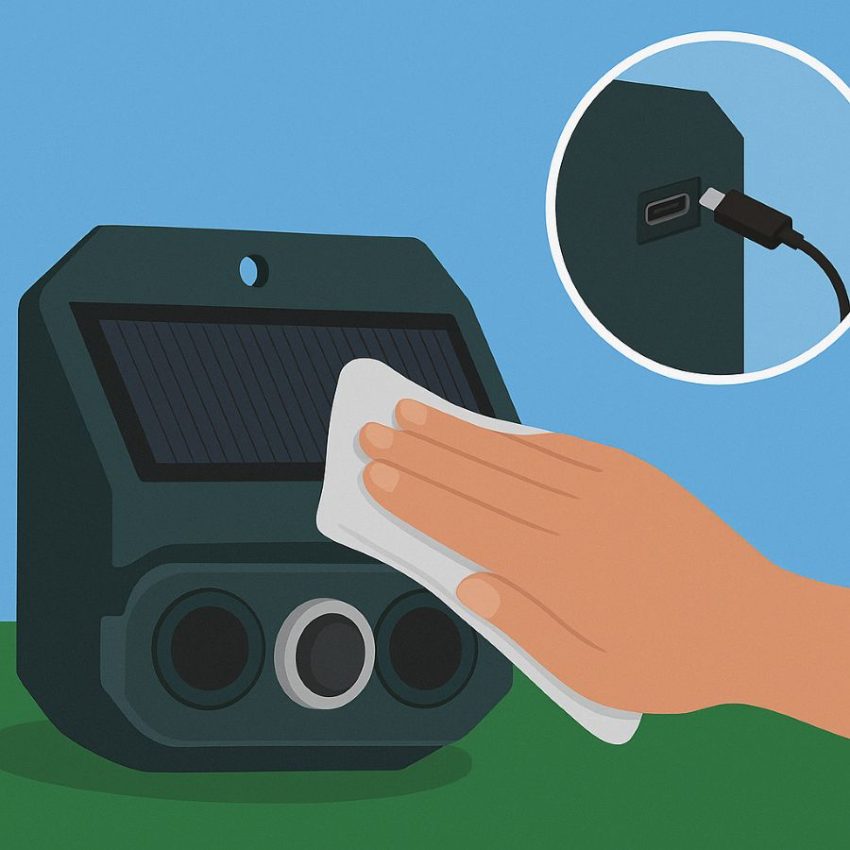
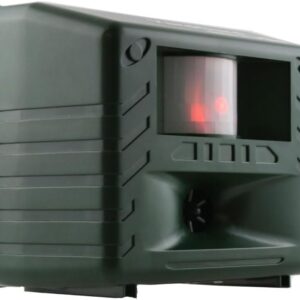
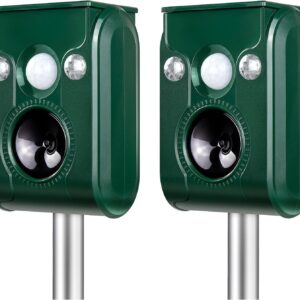
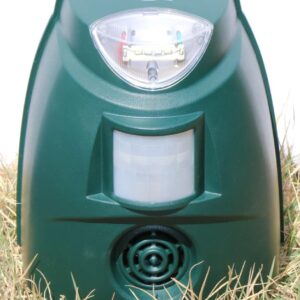
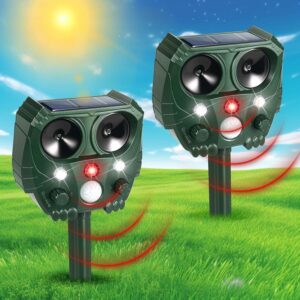
Reviews
There are no reviews yet.